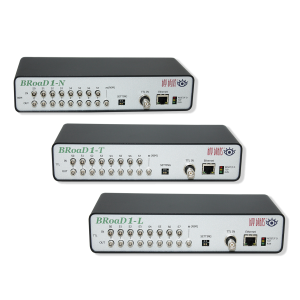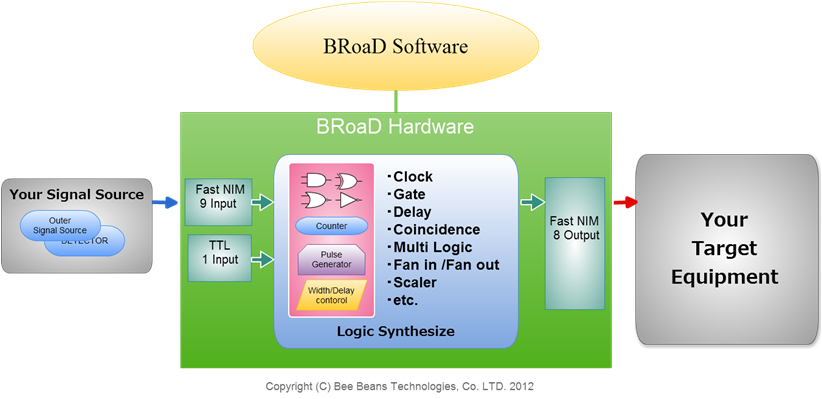BRoaD 1 New

Zoom the image.
The BRoaD1 is a system for easily generating, synthesising and distributing various logic signals in a laboratory environment. In addition to conventional NIM signal versions, TTL and LVTTL signal versions are also available.
The BRoaD1 has three different model numbers with different input/output standards, which are distinguished by the suffix “-N”, “-T” and “-L” at the end of “BRoaD1”.
- NIM signal version BRoaD1-N BBT-028-1
- TTL signal version BRoaD1-T BBT-028-2
- LVTTL signal version BRoaD1-L BBT-028-3
The ability to rewrite user-designed programmes enables the BRoaD1-N/T/L to be used as a combined FPGA platform unit with an input/output section.
The BRoaD1-N/T/L has one NIM input and one TTL input, respectively, for input signals (8 channels)/output signals (8 channels).
Specifications
Common specifications
- LEMO connector (9 inputs, 8 outputs) BNC connector (1 input)
- 1 LEMO connector FastNIM compliant, BNC connector TTL/LVTTL compliant
- Main logic: AND, OR, NOT, XOR, “( )”, Counter, Delay, Measure counter
- LAN: RJ45 connector 10BASE-T / 100BASE-TX / 1000BASE-T compatible
- AC adaptor: Input: 100V-240V 50/60Hz 0.3A / Output: 5.0V 2.0A
Dimensions: W 240 mm x H 50 mm x D 100 mm (excluding protruding parts)
Individual specifications
- BRoaD1-N: LEMO connector for 8 inputs and 8 outputs, FastNIM compliant / Termination resistance 50 Ω
- BRoaD1-T/L: 8-input LEMO connector TTL/LVTTL compliant
- BRoaD1-T: 8-output LEMO connector TTL compliant/termination resistance 9.6 kΩ
- BRoaD1-L: 8-output LEMO connector LVTTL compliant/termination resistor 9.6 kΩ
The logic can be freely reconfigured using the included software, making it easy to verify signal processing logic, switch inputs and compare the outputs of multiple logic circuits.
Created logic can be saved on a PC and downloaded to the device as required, allowing a number of logic configurations to be used repeatedly.
SiTCP technology is used to download logic and receive data via the network. This allows the unit to be placed in a remote location and the logic to be set, changed and measured remotely.
Up to 16 logic types can be stored in the unit’s internal ROM and one of the stored logic types can be set to be recalled automatically when the unit is switched on.

